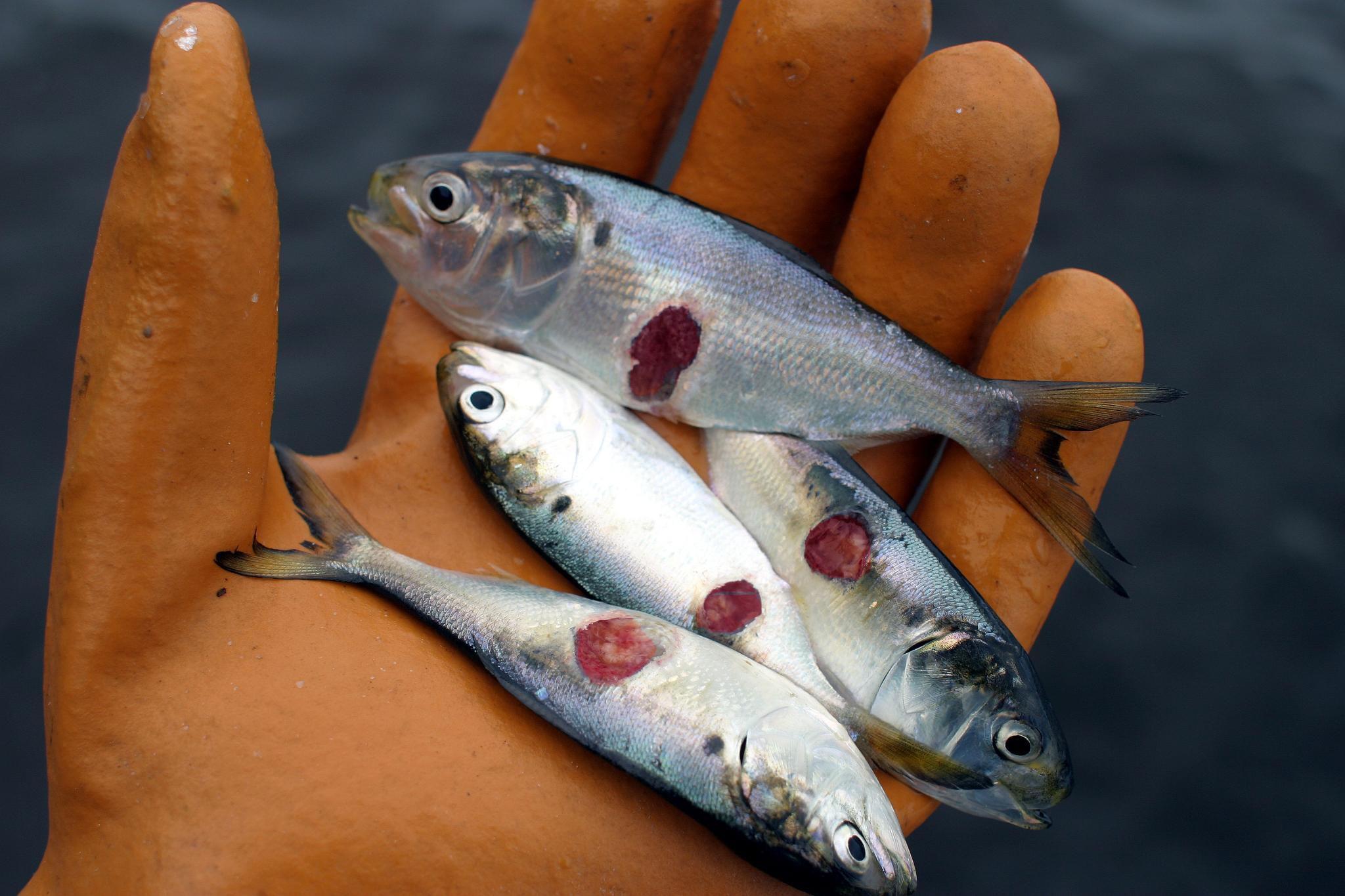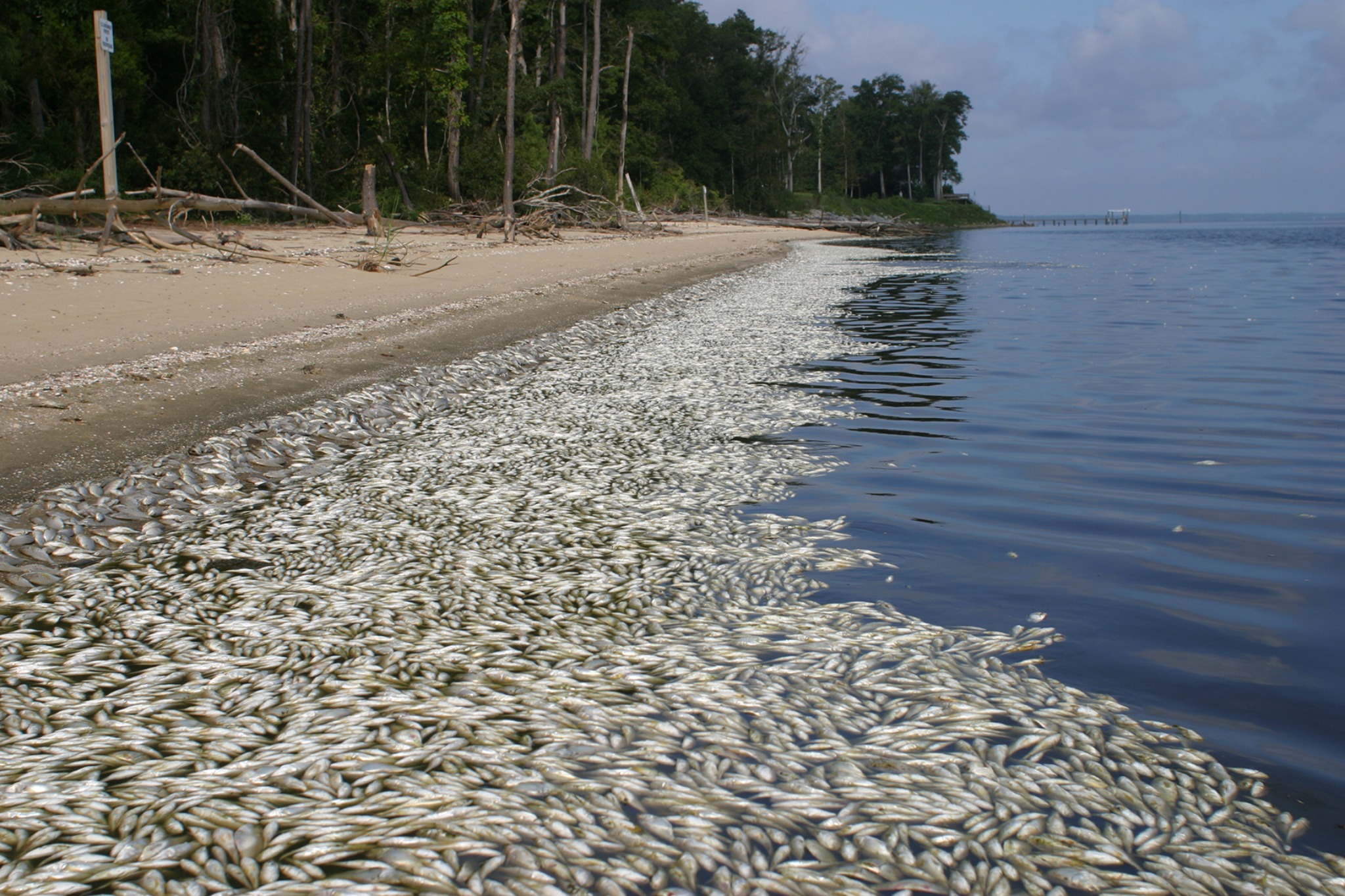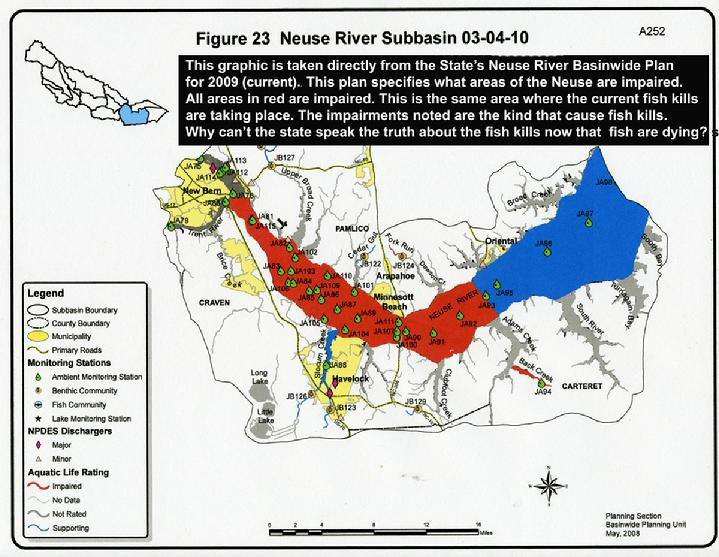--------------------------------------------------------------------------------------------------------------
A fish kill was observed on the Neuse and Trent Rivers on October 18th, 2022. It appears that the kill is confined for now in the Lawson Creek area. More information will be provided as it becomes available.
Fish kills taking place on the Neuse River during September and October 2020

Today is 10/29/2020 and the fish kill on the Neuse River is now into its 5th week. While the numbers of dead fish have not been massive on any one given day, over time, their numbers have been very significant and could rise to the level of the 2009 kill where over 100,000,000 perished. There has been very little press coverage. The state is unwilling and unable to put a stop to this carnage. As time moves on, future generations are being robbed of their inheritance.
__________________________
Fish Kills on the Neuse

Since 1991, an estimated 2,000,000,000 fish have perished on the Neuse River and its tributary, the Trent. Many of these fish had open bleeding lesions covering their bodies. Some had holes from one side to the other. Most were menhaden, but at times, fish of all species perished together. These major fish kills were all related to nutrient pollution.
When it all Began

The recorded history of the Neuse dates back over 200 years. Prior to the early 90s, there is no record of fish kills of the magnitude occurring since 1991. This coincides with the inundation of the swine and poultry industries in eastern North Carolina. Earlier, small fish kills did happen, but none were anything like those that started in 1991.
The Neuse Kill Zone

There are impaired waters in most all of the rivers of eastern North Carolina. This 50 square mile area is on the Neuse. It covers waters from New Bern to Cherry Branch. Not shown is an area of the Trent River from New Bern to Riverbend. At times these waters also experience major fish kills. The Trent River has extensive hog and poultry facilities along its shores.
Paradise Lost
Nutrient Pollution
The Sordid History of the Neuse River
just one of the many waters impaired by animal factory pollution
While small fish kills, mostly in the river's backwaters, are relatively normal, there is no record of massive fish kills on the main stem of the Neuse River until the early 1990s. In the 80s and early 90's, due to increasing nutrient pollution from all existing sources, plus two new sources that came on line in the 80s (swine and poultry industry), the history began to change dramatically.
In 1991, the Neuse River suffered one the largest fish kills of any river in America. In a matter of days during September 1991, over one billion fish perished. This is well documented in the scientific literature. The fishermen looked at what was happening in disbelief. Millions upon millions of fish with open, bleeding sores covered the river. No one had a clue as to the cause. Oxygen levels were normal and nothing previously known could explain things. Before it was over, the river and its beaches would be covered with dead and dying fish of all types, but the Menhaden were hit the hardest. The stench from these rotting fish filled the humid air with a putrid smell so foul that only the bravest ventured outside. On the north shore of the river a bulldozer worked late into the night burying as many of the now decaying creatures as possible.
State officials came down to look at the state of the river. They stood there in silence shaking their heads. Kevin Miller of the state's Division of Water Quality was the first to estimate what he saw--a billion fish! The state did not have a clue about what was going on. And it was not just the fish. As was scientifically documented during later fish kills of a similar nature, people had sores on their bodies, the same as the fish. There were reports of people suffering memory loss as well. Fisherman were passing out in their boats and some could not find their way back to their docks or find their way back to their own houses once ashore. It was really bad.
Then, a University of North Carolina scientist, Dr. JoAnn Burkholder, figured out that nutrient pollution was causing the widespread death of fish. In addition to low oxygen kills related to nutrient pollution, she also identified a one-cell animal, a creature so tiny you can put 100,000 of them on the head of a pin. This creature was producing a neurotoxin in the water that was also getting into the air. In the water the toxin paralyzes fish so that the creature can get to blood cells and suck out the contents. Pfiesteria is, simply, a microscopic killer vampire. When the news hit, people got frightened.
In 1995, another major fish kill hit the Neuse River. Tens of millions of fish were dying by the day. The state shut down the river. The fish market crashed. The news of Pfiesteria and what it does to people--the memory loss and respiratory problems--spread. The tourism industry stalled and real estate values dropped. Properties along the river could not even be sold. The pain and suffering that reverberated through the community was unbelievable.
Listening to the River
Another thing happened that is critical to this story. There was a public meeting scheduled for July 1995, to address water quality problems in the Neuse River not related to fish kills but to algae. There was so much vegetation growing in the river in the summer of 1995 that people could not navigate some of the major tributaries to the Neuse in their boats. The vegetation would clog their propellers and their engines would burn out. They complained so much that the Mayor of New Bern and state officials set up a public meeting to discuss the problem. But they postponed the meeting because of the threat of Hurricane Felix hitting the North Carolina coast. They rescheduled the meeting for September 4, 1995. On the very day of that rescheduled meeting the nightmare fish kill of 1991 was in large measure repeated.
In 1995, fish kills on the Neuse had been building in intensity since early August. Once again, on September 4, 1995, fishermen watched as dead and dying fish covered the shores of the Neuse. Highly trained observers worked the waters meticulously to obtain an accurate estimate of the number of dead fish. The estimated number reached was more than 100,000,000. In 1991, it was highly likely that every Menhaden in the river had died. The 1995 fish kill would not be as big, but in large measure that was because the fishery had not yet recovered from the 1991 kill.
On the evening of September 4, 1995, the large town hall meeting room in New Bern was filled nearly to capacity. At no time in the history of North Carolina had that many people attended this type of meeting. When Jonathan Howes, Secretary for Health and Environment, and his staff walked in, you could see the concern on their faces. People were unruly, they were angry and this time it was not just the fishermen. It was the business owners, tourism officials, local elected officials and others from nearly every walk of life. They wanted answers.
Secretary Howes and his staff were on the stage along with a few other scientists. Most of them did not have a clue as to what was happening in the river. The only one who provided any real answers was Dr. Burkholder, who again confirmed that the fish kill was caused by Pfiesteria. After the presentations the panel entertained questions from the audience. Everyone had questions and no one wanted to leave before they got some answers. It was getting late and there was no way all the questions were going to be answered. People began to raise their arms; they began to shout, and the language was not always civil. It was all that Mayor Tom Bayliss of New Bern could do to maintain order in the auditorium. No one but Mayor Bayliss could have pulled that off. Secretary Howes and his staff just made excuses. They denied any connection between what was going on with the river and health problems. Fortunately for us, Secretary Howes had agreed to go for a boat ride the next day to see things for himself.
The events of the next day are clearly recalled. On the way down to the dock, Secretary Howes leaned over and asked, "What's that smell?" The answer, "You're gonna see for yourself." It was rainy and misty; you could hardly see. The skipper navigated the Riverkeeper boat to the middle of the river by compass and depth finder. As the mist cleared, the secretary stepped over to the rail and looked down at the water. The fish were all around the boat doing death spirals, spinning out of control in the water as the neurotoxin took effect. Chunks of their bodies were missing, a hopelessly sad scene. No one said a word. It was the river's turn to speak. Secretary Howes sat silently for about ten minutes, then said, "Take me to shore, I've seen enough." When we got back, he went directly into the Neuse River Foundation office. He stated that he had called the governor. He said he told the governor that the Neuse River was broken and needed to be fixed.
The Governor Stepped In--sort of
Because of health concerns, the governor shut down a major section of the river. The fish markets crashed. The news of
Pfiesteria and what it does to people--the memory loss and respiratory problems--spread like a potent virus. The tourism industry stalled and real estate values went belly-up. The pain and suffering that reverberated through the community was unbelievable. It was one of the most terrible events ever witnessed in New Bern. But state officials still did not take full responsibility for protecting the public and addressing the problem. As state marine patrols were out there chasing people off the river, politicians were holding fish cookouts on the shore in New Bern to try and convince people the fish were safe to eat.
The real problem is that afterward, with the passage of time, apathy set in. As soon as the headlines died down and the tourism and real estate industries stopped screaming, things started to go back to the way they were. Making matters much worse, came the NC Republican dominated legislature. It has been influenced with campaign donations and essentially taken over by polluters, including, but by no means limited to energy, chemical and animal production industries. Favorable environmental laws passed in the 90s were rescinded and new laws making it easier for industries to pollute our ground, air and water were enacted. Even the few good environmental laws still in existence are not being enforced. This is because state environmental agencies are grossly understaffed.
Fish Kill Excuses
When fish die in the Neuse River and other eastern North Carolina waters, the state's "excuse factory" goes into action. Although the cause is almost always due to nutrient pollution, the state avoids saying that. What the state does to counteract this fact is to avoid any mention of pollution. They make excuses and some are clearly ridiculous. Any excuse that in even the most extreme way points to a natural event is fair game. Here are some of the most ridiculous things ever used as excuses for why the fish are dying.
These include:
Fish died because of a wind shift
Fish died because of too much rain
Fish died because of no rain
Fish died because of high water
Fish died because of low water
Fish died because of calm waters (no wind)
Fish died because of rough waters (too much wind)
Fish died because they got hit by boat propellers
Fish died from salt wedge intrusion
Fish died because of upwelling
Fish died after being hit by lightning
Fish died from wounds inflicted by predator fish
Fish died from no oxygen on the bottom
Fish died because of no oxygen on top
Fish died because they are too stupid to avoid areas of low oxygen
Fish died by committing suicide when they schooled together in large numbers
Fish died because the commercial fishery shut down and now there are too many fish in the river
Fish died from sores caused by rough water raking their bodies over shells on the river bottom
There are fish kills on the Neuse River every year. The small ones with kill numbers in the thousands go largely unreported. Larger kills that are reported are only partially documented by the state. The state traditionally downplays fish kills. To do otherwise would require expensive corrective action. For the most part, the estimating of numbers of fish kills has fallen on highly trained citizen volunteers. They meticulously follow state protocols when estimating the numbers of dead fish. It is a painstaking effort that requires both time and dedication.
Major fish kills occurred on the Neuse and other eastern North Carolina rivers throughout the 1990s and continue to the present. The numbers have declined over the past 5 years; however, that is attributed more to the decline in fish population in the prime fish kill area as well as the lack of coverage by the state and media, than pollution abatement.
The below chart provides just one example of how the state downplays fish kills.

This is example text. Please click here to edit the text.
State fish kill records are fatally flawed
Scientific reports using these data are deemed unreliable.
NC - A POOR HISTORIC ENVIRONMENTAL RECORD, NOW MUCH WORSE’
This state is 2nd from the bottom in spending on its environmental agency. The environmental agency is presently in an “iron-fist” grip of the reactionary state legislature. It rarely samples fish kills and has altered its fish kill records to falsely “eliminate” major kills and make the few kills it reports “much smaller,” so that the state looks better for coastal tourism.
The state historically has had among the poorest fish kill records in the Southeast with respect to assessment of causality (Lowe et al. 1991). Until 2011, NC was 43rd to 47th per capita among the states in environmental protection spending (World Resources Institute, Southern Environmental Law). The agency received less than 1% of the state’s budget.
North Carolina is #1 among U.S. states in having “downsized” its environmental agency since 2008, and it is 2nd from the bottom among the states in spending per capita on its environmental agency (see
https://ballotpedia.org/Environmental_spending_in_the_50_states). As part of the “slash and burn” policy imposed by the state legislature, the environmental agency now has 40% of the budget it had in 2008 and has lost about 2/3rds of its employees in the past ~decade.
In response to more political pressures, fish kill information was further “altered” to improve international press, and many more fish kills were either removed or “artificially downsized”. When the late Mr. Kevin Miller (who sampled estuarine fish kills on the Pamlico and Neuse in the 1980s-early 1990s) examined the “official” fish kill database, he expressed frustration that many kills he had sampled - including even the largest recorded kill in NC history, of more than a billion fish in Sept.-Oct. 1991 on the Neuse - had “disappeared” from the state’s database, along with accompanying notes such as use of bulldozers to remove piles of dead fish from shorelines in that 1991 kill.
In another effort to improve the state’s image for tourism and retirees, a “Fish Kill Rapid Response Team” was created in the mid-1990s but, even then, was subject to serious funding constraints. This problem is described in the peer-reviewed literature using an example from a major 1995 fish kill (Burkholder et al. 1999 peer-reviewed publication). In that example, a highly conservative estimate of 15 million fish died, based on data collected following U.S. Fish & Wildlife Service sampling protocols. A local environmental group, working more extensively under state training and guidelines, estimated a number more than 6 times that of the US Fish and Wildlife Service. In marked contrast, due to inadequate sampling, the state environmental agency reported only 2 million dead fish. The agency did not extrapolate or otherwise attempt to account for the many days during the fish kill when no data were taken by state workers because they could not travel to the fish kill. Local citizens, considering such information, described the NC Rapid Response Team as “neither rapid nor responsive.” The short-lived Rapid Response Team was eliminated 2009 due to ‘lack of funds.’
FACTUAL INFORMATION ABOUT NC ESTUARINE FISH KILLS VS. THE ALTERED NC “OFFICIAL” DATABASE
The facts surrounding the termination of the Rapid Response Team in 2009 are most revealing. As discussed in this fish kill page, more than a 100,000,000 fish perished in a kill within a 40 square mile area of the Neuse below New Bern during September and October 2009. This kill was ongoing for over 30 continuous days. Along with the Rapid Response Team, the Neuse Riverkeeper and others who were formally trained by the state to estimate fish mortality were on the river conducting estimates. After little more than 10 days, the Rapid Response Team had reported an estimated 13,000,000 dead fish. At that point, without explanation, and under protest of the Neuse Riverkeeper and the Neuse River Foundation, the rapid Response team was withdrawn from the River. As the fish kept dying, state officials ignored repeated requests of the Riverkeeper to get back on the river. The Rapid Response was not permitted by their superiors to do so. The message was clear: The state record would be limited to 13,000,000 dead fish, a number that is grossly in error. While this episode demonstrated flagrant abuse of authority, similar conduct of the state had been noted on many of their other fish kill estimates as well.
OTHER FALLOUT FROM USE OF THE “ARTIFICIALLY DOWNSIZED” STATE FISH KILL DATABASE
The state’s “alteration” and “downsizing” of the fish kills database could not control the fact that the 1991 kill mentioned above, and various others, had been described in peer-reviewed publications in highly respected science journals. The publications had used the state’s fish kill information that was available in the 1990s, and had acknowledged various state personnel who had sampled the kills and provided the estimates of numbers of fish impacted. Moreover, a report that preceded the publications was partly funded by the state environmental agency. The report was accepted, and the state personnel who were acknowledged did not contest the data, which were accurately listed. Yet, through lack of knowledge or for other reasons, there have been various attempts to use the state’s “rewritten history” on its estuarine fish kills and deny the existence and/or the causes of those kills.
A recent example is an article in what has been referred to as an online predatory journal. Such journals are said not to follow the strict provisions required in peer reviews. This article (Pietrafesa et al. 2018, Oceanogr. Fish. Open Access J. 7(1): 555701) claims to compare fish kills in the Pamlico and Neuse estuaries and their causes. One major flaw with this report is that it relied on fish kill data contained in the state’s altered records. These data are known to be altered and falsely reported, as previously described in peer-reviewed science journals. Conclusions concerning fish kills numbers based on such data are deemed to be without merit. Concerning this report, the following additional comments are noteworthy. The article:
· Begins with a series of poorly written statements including a personal attack on a respected scientist. The authors used only one reference, and it did not support their writing. Many peer-reviewed science publications support the scientist’s work, including publications by scientists in independent laboratories who corroborated/strongly supported the work (as examples, Marshall et al., Gordon et al. 2002, Moestrup et al. 2014).
· The authors dismissed the “one scientist’s claim” (actually, as explained above, valid science that was corroborated by other scientists independently) because it was challenged by some scientists, as is the nature of science – yet the reference they used “in support” of their writing did not challenge the scientist’s work.
· The authors misstated that the organism identified by the scientist (and by others, as above) as the cause of some fish kills was just a scavenger of dead fish. Yet, • the organism was confirmed to be highly toxic to fish, as published in the Proceedings of the National Academy of Sciences; • toxins the organism produces have been formally characterized (Moeller et al. 2007); and • the lead scientist who characterized those toxins received the most prestigious award of the year, the Gold Medal in Science, by the federal agency NOAA.
· The authors claimed that “proof of what actually occurred on the Neuse was never scientifically documented”, and that the Pamlico Estuary was “never part of the public or scientific community fish kill discussion”. The truth: A large body of peer-reviewed science published in international, reputable science journals documented causes of fish kills on the Neuse during the same period the paper claims to have examined; and the first major kill studied and reported in the science literature by the scientist they attacked was in the Pamlico Estuary.
Science References Cited Above
Beninger, P.G., J. Beall, and S.E. Shumway (2016) Editorial - Debasing the currency of science: The growing menace of predatory open access journals. Journal of Shellfish Research 35: 1-5.
Burkholder, J.M., A.S. Gordon, P.D. Moeller, J.M. Law, K.J. Coyne, A.J. Lewitus, J.S. Ramsdell, H.G. Marshall, N.J. Deamer, S.C. Cary, J.W. Kempton, S.L. Morton, and P.A. Rublee. 2005. Demonstration of toxicity to fish and to mammalian cells by Pfiesteria species: comparison of assay methods and multiple strains. Proceedings of the National Academy of Sciences (USA) 102: 3471-3476.
Burkholder, J.M. and H.G. Marshall (2012) Toxigenic Pfiesteria species: updates on biology, ecology, toxins, and impacts. Harmful Algae 14: 196-230.
Glasgow, H.B., J.M. Burkholder, M.A. Mallin, N.J. Deamer-Melia, and R.E. Reed (2001) Field ecology of toxic Pfiesteria complex species, and a conservative analysis of their role in estuarine fish kills. Environmental Health Perspectives 109: 715-730.
Gordon, A.S. and B. Dyer (2005) Relative contribution of exotoxin and micropredation to ichthyotoxicity of two strains of Pfiesteria shumwayae (Dinophyceae). Harmful Algae 4: 423-431.
Gordon, A.S., B.J. Dyer, D. Seaborn, and H.G. Marshall (2002) Comparative toxicity of Pfiesteria spp., prolonging toxicity of P. piscicida in culture and evaluation of toxin(s) stability. Harmful Algae 1: 85-94.
Marshall, H.G., A. Gordon, D. Seaborn, B. Dyer, W. Dunstan, and A. Seaborn (2000) Comparative culture and toxicity studies between toxic dinoflagellate Pfiesteria piscicida and a morphologically similar cryptoperidiniopsoid dinoflagellate. Journal of Experimental Marine Biology and Ecology 255: 51-74.
Moeller, P.D.R., K.R. Beauchesne, K.M. Huncik, W.C. Davis, S.J. Christopher, P. Riggs-Gelasco, and A. Gelasco (2007) Metal complexes and free radical toxins produced by Pfiesteria piscicida. Environmental Science and Technology 41: 1166-1172.
Moestrup, Ø., G. Hansen, N. Daugbjerg, N. Lundholm, J. Overton, M. Vestergård, J. Steenfeldt, A.J. Calado, and P.J. Hansen (2014) The dinoflagellates Pfiesteria shumwayae and Luciella masanensis cause fish kills in recirculation fish farms in Denmark. Harmful Algae 32: 33-39.
Overall “Take-home Message”: This state’s dishonest conduct regarding its fish kill records cannot erase the truth of what has been published in peer-reviewed science and what has been observed by the many people who assessed these kills. An old adage surely applies here:
The state’s “Lies shout, but the truth still whispers.”


